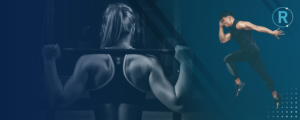A Hooker’s guide to rugby fitness
- Training Team
- Positions
Like all forward positions, hookers need a variety of attributes to be successful. Playing a crucial role in scrums and lineouts, this is a position that requires a lot of skill as well as brute strength, fitness, power, and speed.
Hookers are also in the enviable position where they can even secure the occasional try, as they are perfectly placed to nip over and score from a lineout close to the try line. Agility is an important part of hooker training – they need to know how to sidestep!
Skills aside, hookers need to develop a wide range of fitness components. This article is not intended to be a workout but, rather, provide you with a variety of training ideas to develop your fitness for this position.
Strength
Front row forwards need to be strong. The front row is the only position where there is a direct and repeated confrontation time after time. The props might be there to provide you with support, but the hooker still has to do their fair share of the work!
Front row forwards need leg, back, and neck strength and the best place to develop that is in the gym. Scrummaging is often an isometric activity which means although large amounts of force are generated, there is very little movement. This should be reflected in training.
Strength exercises
1) Barbell squat – if you want strong legs, you have to squat. Hookers, with their typically mesomorphic-endomorphic builds, are usually well built for squats. Front squats and back squats are similarly valuable, and Zercher squats and box squats are also useful.
To make squats more hooker-specific, add a mid-rep pause. As you squat down, hold the halfway point (knees bent to 90-degrees) for a count of three and then explode back up. Bone up your squats with this video:
2) Deadlifts – another key front row exercise, the deadlift develops the entire posterior chain of hamstrings, glutes, and lower back. The upper back also gets in on the action, as too do the forearms. Deadlifts from the floor and from knee-high pins or blocks, as well as deficit deadlifts, trap bar deadlifts, and Romanian (semi-straight leg) deadlifts are all good choices for hookers.
Make deadlifts more scrum-specific by adding a pause at around knee-height on the way up and/or on the way down. See more on paused deadlifts in this video:
3) Good mornings – a controversial exercise in most gyms, the good morning is an excellent exercise for hookers. Why the controversy? Mainly because most people are unable to do this exercise properly! To do a good morning, rack and hold a barbell across your upper back. Stand with your feet hip to shoulder-width apart, knees slightly bent. Without rounding your lower back, hinge forward from the hips until your upper body is roughly parallel to the floor. Stand back up and repeat. Make this exercise a little more comfortable by using a safety squat bar or cambered bar.
Here’s how it should look in action:
4) Neck training – front row forwards need a strong neck. You can build your neck strength by preforming isometrics, using a neck harness, doing variations of the wrestler’s bridge, or performing yielding isometric exercises against a stability ball.
Medicine ball throwing exercises
A long, accurate throw in the lineout can be the difference between possession and scoring, or losing the ball and having to go on the defensive. Just because a rugby ball is light doesn’t mean hookers shouldn’t train their throwing muscles. Throwing practice and training should be part of every hooker’s workouts.
1) Medicine ball overhead throw – take the ball behind your head and throw for distance. Run after the ball, retrieve it, and throw it again to turn this strength/power exercise into a conditioning drill. Use a staggered stance or feet together as preferred. You can also perform overhead throws against a wall. Here’s a example.
2) Medicine ball sit-up and throw – this exercise will work your core as well as your upper body throwing muscles. Lie on the floor with your legs bent, feet flat on the floor, and your medicine ball in your hands and resting behind your head. Sit up and throw the ball at a wall or willing training partner. Catch the ball as it is returned to you and repeat. Increase core activation by doing this exercise while lying across a stability ball. Learn how to do this exercise here:
3) Kneeling medicine ball throw – kneeling throws remove the upper body from the equation so you are free to concentrate on using your upper body. Add an extra element of conditioning by falling forward onto your hands as you follow through and performing an explosive kneeling push-up.
4) Stability ball medicine ball throw – to develop better balance and coordination, perform overhead throws sitting or kneeling on a stability ball. Any lopsided set up or left-to-right imbalances will soon be revealed!
Speed and agility
It’s not enough to be strong and fit, hookers also need to be quick and skillful. While most hookers may lack the speed and agility of the backs, that doesn’t mean they should ignore these attributes.
Long sprints are not normally part of a hooker’s game so brief, explosive efforts should be the focus of their training. Sprints covering 5 to 40 metres should make up the bulk of a hooker’s sprint training, with occasional longer sprints included for conditioning purposes.
Because hookers will usually be running into opposition, sled training will be especially useful. No sled? No problem! You can do resisted sprint training on a treadmill that has been turned off. Just grab the handrail to your front, lean forward, and drive the belt around with your feet. Try 20 sec on and 40 sec off for 10 sets.
For agility, train using an agility ladder or do multi-directional running drills. You’ll find lots of examples in this free e-book.
Cardiovascular fitness
Strength, speed, agility, and skill are not much use if they aren’t backed up with a high level of cardiovascular fitness. After all, you need to be able to keep up with the flow of play from the first whistle to the last.
Props, like all rugby players, need a combination of aerobic and anaerobic fitness. Aerobic fitness is best developed by performing relatively low intensity exercise for prolonged periods e.g. run, swim, or cycle for 40 minutes, whereas anaerobic fitness is best developed through interval training and metabolic circuits.
Of all the training tools available for developing rugby-specific cardiovascular fitness, one of the best is the rowing machine. Rowing offers several important benefits:
- Low impact so ideal for heavier players and those with lower limb aches and pains
- Full body workout
- Requires and develops coordination
- Perfect for interval training
- Increases core stability
- Develops better posture
- Good rowing workouts to try are:
1. Viking rowing workout
This session involves four sets of rowing, each set doubling the distance of the previous one. Treat set as a mini-race, requiring a maximal, all-out, effort to complete.
- Set 1 – 125 meters
- Set 2 – 250 meters
- Set 3 – 500 meters
- Set 4 – 1000 meters
Rest periods between sets should be equal to the amount of time it took to complete the previous set. So, if it takes you 1:45 seconds to complete 500M in set three, your rest period before set four would be 1:45 seconds. As the sprints increase in duration, so do the rest periods.
2. Reverse Tabata
This workout develops the anaerobic energy pathways, specifically the creatine phosphate energy system. It’s essentially an anaerobic power workout. Make sure you work as hard as you can for each and every interval.
- Row 10-seconds
- Rest 20-seconds
- Row 10-seconds
- Rest 20-seconds
- Row 10-seconds
- Rest 20-seconds
- Row 10-seconds
- Rest 20-seconds
3. 2000-meter time trial
Sometimes, in rugby, you have to ignore fatigue and pain, dig deep, and just keep on going. This workout develops not only high-threshold cardiovascular fitness but mental toughness too. It’s a bit too long a distance to be a sprint but short enough you can really go for it. This combination makes for a gruelling 7-9 minutes and, yes, that’s the time you should be aiming for. If you can go sub-7 minutes, consider yourself a good rower.
Just pre-set your rower for 2,000 meters, and then try and cover that distance as fast as you can. Focus on your breathing and technique and, remember, it’s only 2000 meters!
4. 5000-meter time trial
Rowing 5,000 is a good way to develop aerobic fitness. It’s not so far that you have to row slowly, but far enough that you’ll need to pace yourself. 25-30 minutes is an acceptable time for 5,000 meters, but anything around 20-minutes is very good.
New to rowing or need to polish up your technique? Check out this video:
Flexibility
Front row forwards, because of their position in the scrum, need a good level of flexibility, especially in the hamstrings and shoulders. Every workout should end with adequate stretching, and those players lacking flexibility should stretch daily. Players who are serious about improving their flexibility should consider yoga. The fastest fix for overall flexibility is to perform a series of Jefferson Curls at the start of workouts.
In addition to training like a hooker, you also need to eat as well as possible to support muscle growth and recovery. Supplement your diet with stacks that will help your training and recovery to get the most from all of your workouts.
Photo: Andrew Lamerton throws a lineout for Llanelli against Swansea in 1993.


